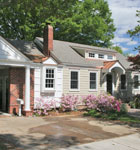1. Hire a reputable contractor for the job
There are plenty of roofing “experts” that lack the experience or credentials of others and tend to underbid the rest of the pack. But when it comes to protecting a home from the elements, it’s hardly the time to take chances. “Getting the right roof system on a house is critical, as is knowing what you’re working with,” Lenzer says, adding that homeowners should seek out contractors that are licensed and insured first and foremost.
 2. Get a thorough, inside-and-out roof inspection
2. Get a thorough, inside-and-out roof inspection
Lenzer says some homeowners do exterior-only inspections of their existing roofs—in some cases not even being present when the contractor stops by—and that’s a big mistake. Reroof America requires customers to give the firm access to the inside of their homes, including the attic, which many people forget about. “By making sure we do all the up-front inspections, it allows us to do it right the first time and to do so in a timely fashion,” Lenzer says.
 3. Have a sit-down consultation with your contractor
3. Have a sit-down consultation with your contractor
“Any time you’re reroofing a house, it can be a hassle for homeowners and neighbors,” Lenzer says, stressing the importance of knowledgeable customers. The better a homeowner understands what to expect—even if the entire process takes only a single day—the less hassle they will experience and the quicker they can get back to their normal routine.
4. Remove shingles and inspect the deck
Before anything new can happen with a roof, it’s important for the contractor to get rid of what’s old. With pitchfork-like tools, old shingles are scraped off and disposed of. “This is probably the dirtiest and hardest part of what the guys do,” Lenzer says. “They’ve got to get all that material off the roof—without dropping nails or debris everywhere—and make sure not to damage the home or the landscaping.” Once this is done, the cleared deck is carefully inspected; finding large gaps or bad decking usually results in the deck being repaired or replaced.
 5. Flash and felt the roof
5. Flash and felt the roof
A roof must be weatherproofed properly around any joints or protrusions (such as pipes and chimneys), so it needs to undergo flashing and felting (the addition of layers of waterproofing, which is usually asphalt-based felt paper or a similar material) before the shingles can be added. “When a roof fails, it’s typically not the shingles that fail,” Lenzer says. “You have to make sure the critical areas of the roof that are more vulnerable to leaks are well protected with the proper material.”
6. Shingle the roof
Shingles—made of asphalt, wood, or any number of specialty materials—are the roof’s outer layer. They are installed one by one from bottom to top. Homeowners typically choose their shingles based on variables such as budget, aesthetics, and type of house. Lenzer says a “cool-roof” shingle (intended to keep a house cooler in hot weather by reflecting light off the shingle itself) is an increasingly popular option.
 7. Create necessary ventilation
7. Create necessary ventilation
Roofs need intake and exhaust vents to perform properly. Adding new ventilation or replacing old ventilation is completed in conjunction with shingling. “A full-length ridge vent is one of the best types of ventilation available, but the specific ventilation product that is right for your home will depend on numerous factors,” Lenzer says.
8. Clean up and perform a final inspection
Reroof America does a thorough cleanup of each project. “There are a lot of individual pieces when you remove and replace a roof,” Lenzer says. “Making sure that we get the magnetic sweepers going around the yard and [that the home] is in as good a condition as when the job started is important to us.” The job supervisor performs a thorough inspection to ensure that the roof was installed correctly and that cleanup was completed. ABQ

 2. Get a thorough, inside-and-out roof inspection
2. Get a thorough, inside-and-out roof inspection 3. Have a sit-down consultation with your contractor
3. Have a sit-down consultation with your contractor 5. Flash and felt the roof
5. Flash and felt the roof 7. Create necessary ventilation
7. Create necessary ventilation

